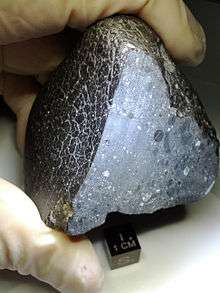Northwest Africa 7034
Northwest Africa 7034 is a Martian meteorite believed to be the second oldest yet discovered.[3] It is estimated to be two billion years old and contains the most water of any Martian meteorite found on Earth.[4] Although it is from Mars it does not fit into any of the three SNC meteorite categories, and forms a new Martian meteorite group named "Martian (basaltic breccia)".[1] Nicknamed "Black Beauty", it was purchased in Morocco and a slice of it was donated to the University of New Mexico by its American owner.[1]
| Northwest Africa 7034 | |
|---|---|
 Northwest Africa 7034, nicknamed "Black Beauty" | |
| Type | Achondrite |
| Clan | Martian meteorite |
| Grouplet | Martian (basaltic breccia)[1] |
| Composition | Plagioclase and pyroxene phenocrysts in a fine groundmass.[2] |
| Weathering grade | Minimal[1] |
| Country | Morocco |
| Coordinates | Unknown (purchased from dealer)[1] |
| Observed fall | No |
| Found date | 2011 |
| TKW | 320 grams (11 oz)[1] |
Discovery and naming
The meteorite was found in the Sahara Desert in 2011[5] and was purchased in Morocco by a meteorite dealer who sold it to a collector in the United States.[1] For this reason the exact geographic coordinates of the find location are unknown, and there is a strong possibility that meteorites reported to have been found in Morocco were, in fact, not. (As Morocco does not have meteorite export control laws.) Like all meteorites that are found in large numbers or sold at markets the name stands for the geographic region (Northwest Africa) and a number, which is given out consecutively.[6] NWA 7034 carries the nickname "Black Beauty".[3] [7]
Description
NWA 7034 is a volcanic breccia that has a porphyritic appearance, consisting of plagioclase (andesine) and pyroxene (pigeonite and augite) phenocrysts that are up to 5 mm in diameter set in a fine grained groundmass. Accessory minerals include chlorapatite, chromite, goethite, ilmenite, magnetite, maghemite, alkali feldspar and pyrite.[4] There are even some clasts present that are made of quenched magma. The groundmass is made from fine grained plagioclase, pyroxene, different oxide minerals, and traces of iron sulfides.[1] The whole rock chemistry revealed that NWA 7034 has the highest water content ever measured in a Martian meteorite.[5] The water might be derived from oceans that used to exist on Mars, but were still present when the volcanic rock, that would eventually become the meteorite, was erupted.[8]
The meteorite contains components as old as 4.42 ± 0.07 Ga (billion years),[9] and was heated during the Amazonian period of Mars.[10] It is the second oldest Martian meteorite known.[4][5][11]
Classification
NWA 7034 is the first Martian meteorite that is a breccia and does not fall in any of the known Martian meteorite groups (shergottite, nakhlite, chassignite and ALH 84001).[2] NWA 7034 was classified as an ungrouped planetary achondrite until the Meteoritical Society approved the new designation "Martian (basaltic breccia)" in January 2013. The iron/manganese ratio is consistent with that of other Martian meteorites, but the oxygen isotopes do not correlate with a Martian origin. The change in oxygen isotope ratios could be explained by removal or addition of heavier or lighter isotopes, or by mixing with a mass with a different isotopic ratio. This could happen during aqueous alteration of the Martian crust. Another explanation would be an isotopic contamination of the Martian crust during impact brecciation.[2]
If it were a terrestrial rock it would be classified as a regolith breccia.[12]
See also
- Glossary of meteoritics
- List of Martian meteorites
- List of meteorites on Mars
References
- "NWA 7034". Meteoritical Society. Retrieved 4 January 2013.
- Agee, C. B.; N.V. Wilson; F.M. McCubbin; Z.D. Sharp; et al. (2012). "Basaltic Breccia NWA 7034: New ungrouped planetary Achondrite" (PDF). 43rd Lunar and Planetary Science Conference. Retrieved 4 January 2013.
- Associated Press (January 4, 2013). Mars meteorite 'Black Beauty' contains most water of any found on Earth, say scientists. The Guardian
- Agee, C. B.; Wilson, N. V.; McCubbin, F. M.; Ziegler, K.; et al. (3 January 2013). "Unique Meteorite from Early Amazonian Mars: Water-Rich Basaltic Breccia Northwest Africa 7034". Science. 339 (6121): 780–785. Bibcode:2013Sci...339..780A. doi:10.1126/science.1228858. PMID 23287721.
- Staff (January 3, 2013). "Researchers Identify Water Rich Meteorite Linked To Mars Crust". NASA. Retrieved January 3, 2013.
- "Guidelines for meteorite nomenclature". Meteoritical Society. p. Section 3.4)c) and Section 3.5. Retrieved 4 January 2013.
- Tills 2013, p. 111.
- "Mars Meteorite May Be Missing Link to Red Planet's Past". Space.com. Retrieved 5 January 2013.
- Nyquist, Laurence E.; Shih, Chi-Yu; McCubbin, Francis M.; Santos, Alison R.; Shearer, Charles K.; Peng, Zhan X.; Burger, Paul V.; Agee, Carl B. (2016-02-17). "Rb-Sr and Sm-Nd isotopic and REE studies of igneous components in the bulk matrix domain of Martian breccia Northwest Africa 7034". Meteoritics & Planetary Science. 51 (3): 483–498. Bibcode:2016M&PS...51..483N. doi:10.1111/maps.12606. ISSN 1086-9379.
- Cassata, William S.; Cohen, Benjamin E.; Mark, Darren F.; Trappitsch, Reto; Crow, Carolyn A.; Wimpenny, Joshua; Lee, Martin R.; Smith, Caroline L. (2018-05-01). "Chronology of martian breccia NWA 7034 and the formation of the martian crustal dichotomy". Science Advances. 4 (5): eaap8306. Bibcode:2018SciA....4.8306C. doi:10.1126/sciadv.aap8306. ISSN 2375-2548. PMC 5966191. PMID 29806017.
- Williams, Rob (4 January 2013). "'Black Beauty' rock is a 2 billion year old unique 'meteorite' from Mars, say scientists". London: Independent. Retrieved 5 January 2013.
- "Elemental and Oxygen Isotopic Composition of Martian Mafic Regolith Breccia NWA 7475" (PDF). Meteoritical Society. Retrieved 14 December 2014.
Book sources
- Tills, Tony (2013), Sciene Year, World Book,Inc., ISBN 9780716605676
External links
- Northwest Africa 7034 via The Meteoritical Society - Database entry of the Meteoritical Society